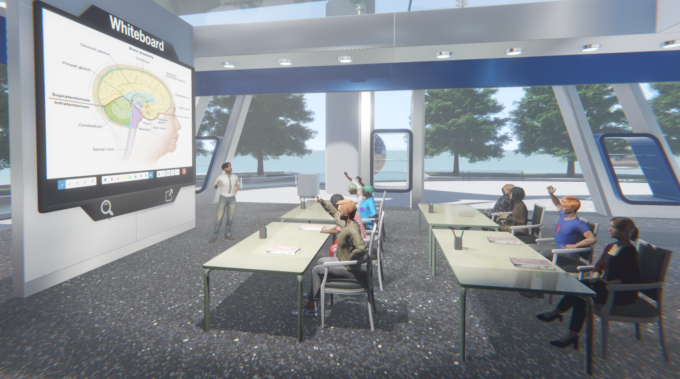Is there an industry that technology hasn’t touched? In the healthcare industry, technological advancements have created more accurate systems of diagnosis and treatment; in the retail sector, the e-commerce boom has radically morphed how consumers approach their daily shopping; the entertainment, hospitality, real estate and finance industries have witnessed similar sea changes thanks to encroaching innovations. Tech is everywhere.
But perhaps its most significant influence is in education – in facilitating and engaging the great minds of tomorrow. In this article, let’s chart tech’s educational impacts through a few short case studies. Here’s how increasing digitization and innovation are elevating education.
VR/AR and “Hands-On” Learning Experiences

Source: openaccessgovernment.org
Universities have road-tested augmented reality (AR) and virtual reality (VR) in classrooms, especially in high-risk learning environments like surgeon training (it’s much safer to learn on a digital module than a live patient!). But, despite what some tech advocates want to believe, immersive technology isn’t a common feature in classrooms – yet.
It will take time and resources before primary and secondary schools fully embrace immersive tech in classrooms. But what we’ve seen so far is promising. AR and VR can help kinesthetic learners enjoy a more “hands-on” approach to learning, interacting with biology concepts, immersing themselves in historical contexts and more. As soon as costs for VR/AR headsets decline, expect to see them become a feature in digital and brick-and-mortar classrooms.
Online Schools: Self-Paced, Flexible and Multimedia Education
Undoubtedly, the biggest shift in education in the last decade has been toward online education. Online schools are better and more organized than ever before. They feature sophisticated multimedia learning models that appeal to all learning types. And they adhere to a self-paced, “asynchronous” model that allows students to work independently of their peers.
That second feature is particularly noteworthy. Asynchronous, online learning is a paradigm shift for the education industry. As opposed to instructor-led learning, which demands a strict universal classroom pace, self-paced studying ensures that students tailor their education to their needs.
If a students has trouble understanding something, they can take more time with their online courses. Conversely, students who feel unchallenged by conventional classroom paces can move through online courses faster, thereby graduating sooner. It’s a more democratic approach to education facilitated by digital schools.
One note of caution: Not all online schools are create equally. The best online schools, like Ontario eSecondary School, boast the same accreditation as their brick-and-mortar counterparts. They are ministry-inspected and observe a meticulous approach to support. The uptick here is that students have an accessible, accommodating alternative where they can learn at their own speed.
Big Data Analytics to Target Areas for Improvement

Source: towardsdatascience.com
Another promising area of emerging technology in education is big tech analytics. Big tech isn’t as scary as it sounds; it merely refers to data stores too large, varied and fast for conventional processing software. Big data analytics refers to AI/ML’s application on these unwieldy data stores to extract precise insights.
In education, some pioneering educators use big data analytics to pinpoint areas for improvement in their curriculum. For instance, big data may allow educators to isolate struggling students and predict their ideal path for remediation – which will have broad impacts on overall scores and learning outcomes. Moreover, teachers can use big data to ensure that their course material is as effective and engaging as possible by testing against engagement models.
These processes are still in their nascent stages, but some pioneering educational departments are beginning to dabble in data. In the coming decade, expect big data analytics to play a more prominent role in education systems.
Gamification: Interactive Decision-Making Modules
Lastly, several educators – in primary, secondary and post-secondary settings – have had great success with gamification. A relatively recent term (at least in popular vernacular), gamification refers to using game mechanics in non-game environments: unlocking levels, going on quests, accruing points, following story narratives, etc.
Experts in education show that gamification applied to curricula can increase student engagement, motivating them to be more active and focused in their learning. This generation of students grew up playing complex video games – it’s no wonder they gravitate toward gamification in their education.
MUVEs

Source: breakroom.net
This one is similar to AR/VR technology – but different enough to warrant its own case study. MUVEs – short for “Multi-User Virtual Environments – are shared digital spaces where students can interact with one another and a shared artificial landscape.
The technology’s use in education stretches back to 1999 (if you can believe it) when California based Numbdeon created a virtual learning world called Whyville. By today’s standards, Whyville looks primitive, but it contained the germ of a fantastic idea.
Now, with the popularity of sites like Meta, educators are revisiting the idea. Not everyone is on board, with some experts concerned that a total remove from reality isn’t the ideal primary environment for education. But others are excited about MUVEs as an inexpensive, engaging, supplementary form of education.
Learning Management Systems
Lastly, we end on a decidedly “unsexy” case study: Learning Management Systems (LMS). LMSs might not have the intrigue of big data or the whimsy of virtual reality, but – pound for pound – they have shaped modern education more than either of those technologies combine.
Basically, LMSs allow for streamlined documentation, reporting and administration among school employees. They manage content, syllabi, grades, transcripts, meeting minutes and discussion boards. It’s hard to oversell how critical the LMS has been to the health of contemporary school systems. Suffice it to say: The technology certainly deserves a place on this list.
Some of these case studies are commonplace (like online schools and LMSs), while others appear on the bleeding edge of education (big data and AR/VR). Still, each is elevating the effectiveness of education in some way. You can expect to see a wider embrace of these tech applications in the future as up-and-coming educators continue to embrace change and innovation.
And things will only snowball from there. As a new generation grows up around today’s “emerging tech,” they will view it as commonplace. When it’s their turn to innovate the educational system, they will dream up solutions we can’t even fathom. If you want to learn more about technology and its utilisation in education, check out our article and learn how modern technology improves education and how it could aid you in your studies.







